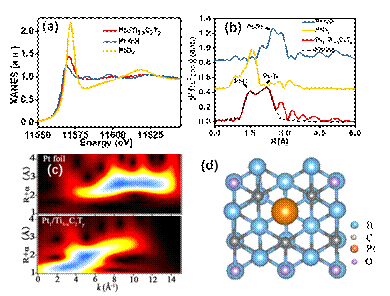| MXene (Ti3C2) Vacancy-Confined Single-Atom Catalyst for Efficient Functionalization of CO2 |
| From: PublishDate:2020-07-29 Hits: |
A central topic in single-atom catalysts (SACs) is building strong interactions between single atoms and the support for stabilization. These interactions would not only contribute to the stability of the atoms but also exert great influence on their electronic structures and in turn catalytic performances. So, it is of fundamental importance to explore and develop new supporting materials and new fabrication methods for SACs. A team from Department of Chemistry of Tsinghua University first used ultrathin two-dimensional Ti3-xC2Ty MXene to anchor single atoms and used them as SACs for efficient functionalization of CO2. This team reported the preparation of stabilized single-atom catalysts via a simultaneous self-reduction stabilization process at room temperature using nanosheets characterized by abundant Ti-deficit vacancy defects and a high reducing capability. The obtained Pt1/Ti3-xC2Ty offered a green route to utilizing greenhouse gas CO2, via the formylation of amines, as a C1 source in organic synthesis. DFT calculations revealed that, compared to Pt nanoparticles, the single Pt atoms on Ti3-xC2Ty support featured partial positive charges and atomic dispersion, which help to significantly decrease the adsorption energy and activation energy of silane, CO2, and aniline, thereby boosting catalytic performance. These results would open up new opportunities for the fabrication of SACs and the applications of MXenes in organic synthesis. This work was selected as cover paper and reported by “Chemical & Engineering News” with the title of “MXene serves as support material for single-atom catalysts”. https://cen.acs.org/materials/nanomaterials/MXene-serves-support-material-single/97/i8
Figure 1 (a) Pt L3-edge XANES spectra. (c) EXAFS. (d) WT. (e) Schematic model. Figure 1 shows how to get the structure of Pt1/Ti3-xC2Ty using XAFS technique carried out at 1W1B-XAFS station of BSRF. Figure 1a shows the XANES spectra of the Pt L3-edge, suggesting that the single Pt atom carries positive charge and its oxidation state is between 0 and +4. Figure 1b shows the Pt EXAFS Fourier transform curves of Pt1/Ti3-xC2Ty and Figure 1c shows its WT contour plot, confirming that Pt atoms are atomically dispersed. After quantitative EXAFS curve fitting, the coordination numbers and bond lengths are obtained, then they get the reasonable structure model (Figure 1d). These results lay a foundation for understanding the catalytic reaction mechanism. Article: Di Zhao,Δ Zheng Chen,Δ Wenjuan YangΔ Shoujie Liu, Xun Zhang, Yi Yu, Weng-Chon Cheong, Lirong Zheng, Fuqiang Ren, Guobing Ying, Xing Cao, Dingsheng Wang, Qing Peng, Guoxiu Wang, and Chen Chen* MXene (Ti3C2) Vacancy-Confined Single-Atom Catalyst for Efficient Functionalization of CO2, J. Am. Chem. Soc. 2019, 141, 4086-4093. |
|
|
| Chinese
- Metal-free efficient photocatalyst for stable visible water splitting——Top ten major scientific progresses in China in 2015
- The nano-resolution imaging platform was awarded the first rate prize of Beijing Science and Technology in 2014
- Beamline 1W1 of BSRF started to runoperate in the couplingparasitic mode of BEPCII
- Synthesis of High Performance Polymer Materials for Field Effect-Transistors
- Surfactant molecular aggregates in green solvents
- GIXRD has played an important role in the characterization of organic thin-film transistors
Science Highlights
Home /
Copyright © 2011 - 2012 Beijing Synchrotron Radiation Facility


